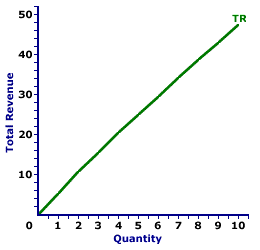
|
|
ANNUITY: The receipt of payments at regular intervals from a established fund. Annuities are commonly used for insurance and retirement programs. It works in this way: A fund, which can be established either through a one-time sum of money or a series of payments, is exhausted over time with fixed, periodic payments. The amount of each payment depends on the interest accrued on the outstanding balance in the fund, and the length of time scheduled to exhaust the fund. For example, if your pension plan is based on an annuity that begins payments at the age of 65, then the size of the payments depends on whether you expect to live 5, 10, 15, or more years and set up payments accordingly. It's very similar to amortization, but in the reverse direction.
Visit the GLOSS*arama
|
|


|

|
                           TOTAL REVENUE CURVE, MONOPOLISTIC COMPETITION: A curve that graphically represents the relation between the total revenue received by a monopolistically competitive firm for selling its output and the quantity of output sold. It is combined with the total cost curve to determine economic profit and the profit maximizing level of production. The slope of the total revenue curve is marginal revenue. Monopolistic competition is a market structure with a large number of relatively small firms that sell similar but not identical products. Each firm is small relative to the overall size of the market such that it has some market control, but not much. In other words, it can sell a wide range of output at a narrow range of prices. This translates into a relatively elastic demand curve. If a monopolistically competitive firm wants to sell a larger quantity, then it must lower the price.The total revenue curve reflects the degree of market control held by a firm. For a perfectly competitive firm with no market control, the total revenue curve is a straight line. For firms with more market control, such as monopolistic competition, the slope of the total revenue curve flattens at larger quantities. The slope of this total revenue curve is marginal revenue. Total Revenue Curve,
Sandwich Style |  |
The total revenue curve for Manny Mustard's House of Sandwich is displayed in the exhibit to the right. Key to this curve is that Manny Mustard is a monopolistically competitive provider of Deluxe Club Sandwiches and thus faces a negatively-sloped demand curve. Larger quantities of output are only possible with lower prices.The vertical axis measures total revenue and the horizontal axis measures the quantity of output (number of sandwiches). Although quantity on this particular graph stops at 10 sandwiches of medicine, it could go higher. This curve indicates that if Manny Mustard's House of Sandwich sells 1 sandwich (at $5.25 per sandwich), then it receives $5.25 of total revenue. Alternatively, if it sells 10 sandwiches (at $4.75 per sandwich), then it receives $47.50 of total revenue. While the curvature is slight, the total revenue curve for monopolistic competition is not a straight line. While the curvature is slight, the total revenue curve for monopolistic competition is not a straight line. For Manny Mustard the total revenue curve has a slightly flatter slope as more output is produced. The changing slope of this curve is due to the changing price.

Recommended Citation:TOTAL REVENUE CURVE, MONOPOLISTIC COMPETITION, AmosWEB Encyclonomic WEB*pedia, http://www.AmosWEB.com, AmosWEB LLC, 2000-2025. [Accessed: July 18, 2025].
Check Out These Related Terms... | | | | | | | | |
Or For A Little Background... | | | | | | | | |
And For Further Study... | | | | | | | |
Related Websites (Will Open in New Window)... | | | |
Search Again?
Back to the WEB*pedia
|



|

|
PURPLE SMARPHIN
[What's This?]
Today, you are likely to spend a great deal of time flipping through mail order catalogs trying to buy either a flower arrangement for your aunt or a birthday greeting card for your uncle. Be on the lookout for rusty deck screws.
Your Complete Scope
This isn't me! What am I?
|

|
|
Parker Brothers, the folks who produce the Monopoly board game, prints more Monopoly money each year than real currency printed by the U.S. government.
|

|
|
"A winner is someone who recognizes his God-given talents, works his tail off to develop them into skills, and uses those skills to accomplish his goals. " -- Larry Bird, basketball player
|

|
CAPM
Capital Asset Pricing Model
|

|
|
Tell us what you think about AmosWEB. Like what you see? Have suggestions for improvements? Let us know. Click the User Feedback link.
User Feedback
|


|


